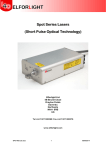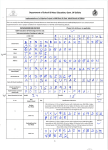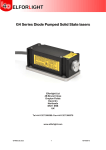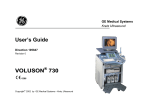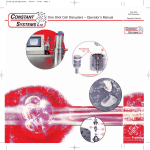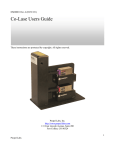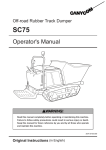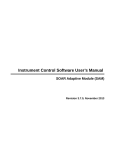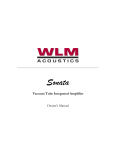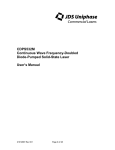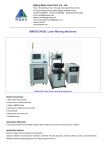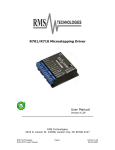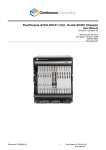Download Spot Series Lasers
Transcript
Spot Series Lasers (Short Pulse Optical Technology) Elforlight Ltd 4B Brunel Close Drayton Fields Daventry Northants NN11 8RB UK Tel +44 1327 300069: Fax +44 1327 300076 www.elforlight.com SPOT V2I6 Manual.docx 1 08/08/2014 NOTICE Elforlight Ltd. has made every attempt to ensure that the information in this document is accurate and complete. Elforlight Ltd. assumes no liability for errors, or for any incidental, consequential, indirect or special damages, including, without limitation, loss of use, delays or lost profits or savings, arising from the use of this document, or the product which it accompanies. The contents of this manual are subject to change without notice. Please contact the factory to ensure you have the latest revision of this document before embarking on critical design. No part of this document may be reproduced or transmitted in any form or by means, electronic or mechanical, for any purpose without written permission from Elforlight Ltd. Elforlight Ltd. acknowledges the trademarks of other organizations for their respective products or services mentioned in this document. © 2012 Elforlight Ltd. All rights reserved. SPOT V2I6 Manual.docx 2 08/08/2014 Contents 1. Basic User Manual 1.1. System Description 1.2. Laser safety 1.3. Recommended safety precautions during laser operation 1.4. System handling, mounting and heat-sinking 1.5. Basic Operation Connections Start-up procedure 1.6. Operation with power variation 2. User Guide: SPOT Power Supply 2.1. Front Panel 2.2. Rear panel 2.3. RS232 commands SPOT V2I6 Manual.docx 3 08/08/2014 1.1. System Description The SPOT laser systems consist of a laser head with a separate power supply unit. The power supply unit contains the drive circuits for the pump laser diode and the temperature control of the laser system, as well as the DC supplies for these modules and to supply the HV for the Pockels Cell. There is an interconnecting cable from the laser head which is hard wired into the laser head while having a 37 way ‘D’ connector for connection to the power supply unit. The power supply requires a mains input of 100-240 VAC, 50 or 60 Hz, capable of providing up to 200VA. SPOT lasers are designed to generate short pulses of laser output at 1064nm (and harmonics if specified). The output power level will depend on the model but it should be remembered that all SPOT lasers emit laser radiation which is potentially hazardous and it is therefore strongly recommended that before operating the laser for the first time users should thoroughly familiarise with the contents of this manual. Of particular importance are the sections dealing with safe operation of the laser and general safety issues. Please refer to Section 2 for full details of power supply operation. Q-switch voltage adjustment with repetition rate With variation of repetition rate up to 50 kHz, it is necessary to adjust the high voltage applied to the Q-switch to optimise output in terms of pulse width and stability. This can be done by monitoring the output pulse on a photodiode and oscilloscope whilst adjusting the voltage using the 10 turn potentiometer (if fitted) on the front panel. Voltage values are given in the test data table above for various repetition rates. The potentiometer (if fitted) can be locked by sliding the plastic lever to the right, and unlocked by sliding it to the left. SPOT V2I6 Manual.docx 4 08/08/2014 1.2. Laser Safety This handbook contains a description of controls, adjustments and procedures for normal operation of the laser. CAUTION - Use of controls or adjustments or performance of procedures other than those specified herein may result in hazardous radiation exposure. Classification Elforlight SPOT series lasers are classified as class 4 Lasers as defined by BS EN 60825-1:1994 and by the United States Centre for Device and Radiological Health (CDRH) 21 CFR Ch. 1 subsection 1040. This designates potential danger of eye or skin damage by exposure to direct or scattered radiation. It is recommended that all users should thoroughly familiarise themselves with these safety standards before operating the laser for the first time. It should be noted the all SPOT lasers are designed as OEM sub-systems. As such they do not comply with all the requirements of BSEN 608251:1994 and CDRH 21 CFR Ch. 1 subsection1040. It is the user’s responsibility to ensure full compliance with these standards. Emission The laser emits CW or pulsed radiation at 1064nm, 532nm and 355nm (or as otherwise specified). Powers up to 2Watts may be generated. The laser head also contains a laser diode emitting radiation at 808 nm within the head package. THE LASER HEAD COVER MUST NOT BE REMOVED. No customer serviceable parts are contained therein. Such access may invalidate any warranty offered by the manufacturer. Indicators An emission indicator on the front panel of the power supply indicates that laser emission is possible. External interlock The SPOT series laser systems are provided with an external interlock facility which is available on a Neutrik 3 way socket on the rear panel. This connector requires contact closure to enable laser operation. The laser is supplied with a shorted connector, but it is recommended that the short be replaced by a link into an external interlock chain - e.g. a room door switch or enclosure cover switch. If the interlock is broken, it is necessary to power down the laser at the keyswitch, then remake the interlock connection and commence the start sequence again to resume laser output. SPOT V2I6 Manual.docx 5 08/08/2014 1.3. Recommended Safety Precaution during Laser Operation The laser should be used in an enclosed area with access restricted to trained personnel. The area should be clearly labelled and the entrance marked with the class of laser (Class 3B). Only trained personnel should be allowed to use the laser. The key must be inserted in the keyswitch and turned to enable the laser to operate. The key is captive in the operational position. As such, the key should be removed from the laser when not in use, and / or unattended, and stored in a safe place. Eye and skin exposure to direct or scattered laser radiation is hazardous and should be considered potentially extremely harmful. Suitable eye protection should be worn at all times whilst laser output is possible. Contact Elforlight for advice on suitable eye protection products. The laser beam path should be terminated with a non-reflecting beam stop. Beam paths should be enclosed where possible, and should not be at eye level if practical. Care should be taken that all mirrors and optics used are securely positioned and fixed to prevent movement. Care should be taken at all times to prevent stray reflections from surfaces in the beam path. SPOT V2I6 Manual.docx 6 08/08/2014 1.4. System Handling, Mounting and Heatsinking It must be appreciated that any solid state laser system, especially the laser head, is a sensitive piece of scientific equipment. Whilst every effort has been made to provide a product that is rugged and reliable it is essential that the laser head is handled with care – especially when mounting. Do not drop or subject the head to impact shock such as placing it down hard on a surface. ANY DAMAGE OR MALFUNCTION OF THE EQUIPMENT DUE TO EXCESSIVE FORCE MAY INVALIDATE ANY WARRANTY. 1.5. Basic Operation The SPOT series Diode Pumped Laser Systems are designed for simple, user-friendly control with the minimum of user defined parameters. SPOT lasers are designed as fixed power level devices under automatic operation, or power can be varied by adjusting the pump diode current via RS232 interface. The power drawn from the AC mains is less than 200 VA (typically approx. 50 VA). The laser head incorporates laser diode protection circuitry and therefore the laser diode is protected even when disconnected from the laser power supply. However, Elforlight recommend the observance of full anti-static precautions during connection and disconnection of the system sub-units. Please contact Elforlight for recommended anti-static procedures. Connect the laser head to the power supply unit using the 37 way ‘D’ connector socket on the rear of the power supply. Be sure that the cable is kept away from the laser beam path. Ensure the external interlock connector is in place in the socket on the PSU rear panel. Ensure that the external interlock circuit is closed, either by use of the supplied shorted connector (temporarily for test only), or via a usersupplied door or enclosure protection circuit. This interlock should be incorporated into an area or enclosure interlock system. Please contact Elforlight for advice regarding suitable interlock arrangements. Either connect a user supplied TTL trigger signal to the Trigger BNC connector on the laser head or connect a BNC cable from the PSU rear panel “trigger out” BNC connector to the laser head “Trigger” BNC to run on the internal trigger. In the latter case, select the desired operating frequency using the front panel switch: 1,5,10, or 25 kHz. These values are approximate and provided for the convenience of the user. It is anticipated that in most applications the SPOT laser will be externally triggered. Connect the mains cable to the rear panel socket. Apply power, switch on the rear panel rocker switch integral with the mains inlet, and turn the key switch to the ON position. SPOT V2I6 Manual.docx 7 08/08/2014 Operation: The SPOT laser executes a start-up procedure during which the output power will vary. During this sequence, the front panel LED emission indicator flashes at 0.5 Hz. Only when the LED is on continuously is the laser stabilised and ready for use. Before this, lower or higher powers may be observed from the laser. The SPOT laser exhibits two different start-up sequences depending on the length of time the unit has been connected to the mains supply. These may be described as: 1. ‘Cold start’ sequence. 2. ‘Warm start’ sequence. 1. The cold start sequence is activated when the system has been powered down and is subsequently reconnected to the mains supply, that is, on initial start-up. 1.1 Connect power supply to mains supply and switch ON. Insert keyswitch and turn ON. The cold start sequence now begins with a thermal stabilisation period. From power up this phase takes a total of 4 minutes. During this period no laser output will be generated irrespective of whether the key-switch is in the ‘OFF’ (anticlockwise) or ‘ON’ (clockwise position). The keyswitch may be switched ‘ON’ at any time during this 4 minute period without prolonging the next stage of start-up. After the above 4 minute ‘warm up’ period, upon turning the key switch, or immediately after the “warm up” period if the key has already been turned, the supply switches automatically to a current ramp mode which varies with parameter settings but should last no more than 2 minutes. During this period some laser light may or may not be emitted depending on the individual set up parameters of the laser. After the above current ramp period the laser is put into a 2 minute stabilisation mode. At the end of this period the Emission indicator will remain permanently on and the laser is ready for use. The warm start sequence is activated any time the key-switch is moved from the ‘OFF’ position to the ‘ON’ position provided the system has been powered up for at least 4 minutes. The warm start sequence activates the final two periods as in 1.1 above; that is the ‘ramp period’ and the ‘stabilisation’ period. Once the laser is running, monitor the output pulse shape with a photodiode and oscilloscope. The HV adjust (if fitted) potentiometer can then be fine-tuned for best stability and minimum pulse width. This setting will vary with drive level and repetition rate. SPOT V2I6 Manual.docx 8 08/08/2014 NOTE (1) if the system is powered down even momentarily at any time, when the system is powered up subsequently the system will automatically revert to the cold start sequence. NOTE (2) during the ‘ramp’ and ‘stabilisation’ operation phase the laser output power will vary significantly from the specified output power. This behaviour is quite normal as during this period optical stabilisation is occurring. NOTE (3) breaking the interlock chain causes the laser to shut down. Once the chain is remade, it is necessary to turn the key off then on to restart the laser. As long as power has not been removed, this will then cause the laser to start in the “warm start” sequence describes above. 1.6. Operation with power variation Power variation is possible by RS 232 interface, with commands sent from a dumb terminal. The programs Terminal and/or HyperTerminal are provided with Windows software and can be used. The program should be configured with the parameters listed below. 9600 baud 1 start bit, 8 data bits, no parity and 1 stop bit No hardware handshaking No flow control To operate the laser using power variation by RS 232 interface, first boot the computer, run “Terminal”. Then connect the RS232 lead, and power up the laser as described above. An introductory message appears confirming PSU SEEPROMs detected (Head SEEPROM not detected is normal and not a fault), Digipots 1&2 detected, and listing SPOT software version e.g. V2I6. Turn the key. A message “Warm up” confirms that a 4 minute warm up period is in progress, followed by “Current Ramp” and “Stabilisation…Please Wait”, then after 2 minutes “System Ready” confirms the laser is operating. During this start-up phase, the emission LED flashes. Once ready, the emission LED is on solid. The “+” and “-” keys can then be used to increase and decrease the pump diode current and hence laser power. The current is set by an 8 bit Digipot, with values 1 to 254 being accepted. At each key press, the value “xxx” is returned. Xxx is the value between 1 and 254. See test data for calibration of values with current and corresponding power output. SPOT V2I6 Manual.docx 9 08/08/2014 2. SPOT Power Supply The SPOT supply also contains: An OEM 18-04 Controller A triple rail DC supply for the above A 5V DC supply for the high voltage switch in the HV module A further adjustable DC supply to drive the high voltage supply in the HV module A cooling fan Interconnecting wiring to bring limited functionality of the 18-04 supply to the front panel The SPOT laser software is limited in functionality. It enables the user to vary laser power by varying pump diode current, and to check the laser status. SPOT V2I6 Manual.docx 10 08/08/2014 2.1. Front panel 1. Emission indicator A yellow LED. Flashes during warm up, continuously illuminated when lasing possible. 2. Key switch The key switch enables laser output. See discussion of start-up sequence for details. 3. HV adjust potentiometer (if fitted). Adjusts the high voltage applied to the Pockels Cell to allow operation over a wide range of repetition rates. See test data for settings. 4. TTL Control Switch This 5 position switch allows the user to select internal or external triggering, and to trigger internally at frequencies of 1,5,10, or 25 kHz. Emission Indicator Key Switch SPOT V2I6 Manual.docx TTL Control High voltage adjust (if fitted) 11 08/08/2014 2.2. Rear panel 1. Mains inlet The mains inlet is a standard IEC connector. A suitable mains cable is usually supplied with the laser, as appropriate to the local supply. The mains inlet is fused and switched. Fuse rating is 5 Amps, slow blow (T). 2. RS232 cable Connects laser PSU to serial (COM) port of computer. Computer runs dumb terminal program such as Terminal or Hyperterminal. PSU end is a round 5 way DIN connector. 3. External Interlock connector A 3 way Neutrik connector. Contact closure between pins 1 and 3 is required to enable laser operation. Laser is supplied with a connector with a shorting link in place. 4. Laser head 37 way D-connector: Provides laser diode drive current, temperature control and monitoring of laser functions. THIS CONNECTOR SHOULD NEVER BE CONNECTED OR DISCONNECTED WHILST THE LASER SYSTEM IS POWERED UP. 5. Safety fuse for laser head Carries +5V supply to laser head. Fuse rating is 1.25A, slow blow (T). 6. Trigger out connector This BNC connector provides TTL trigger output to be taken to the laser head Trigger BNC for internal triggering at the frequency selected by the front panel switch. 5 1 SPOT V2I6 Manual.docx 6 4 12 2 3 08/08/2014 2.3. SPOT Laser RS232 Commands Allows User to change laser diode current (Iset), and thus laser power + Increment Iset parameter by one - Decrement Iset parameter by one ? Request status Q Request software version number RS232 protocol: 9600 baud 1 start bit, 8 data bits, no parity, 1 stop bit No hardware handshaking No software handshaking RS232 Cable wiring: PC End Laser End 9 way 9 way D type D type Socket Plug 1 2 ------------------- 2 3 ------------------- 3 4 5 ------------------- 5 4-6 7-8 SPOT V2I6 Manual.docx 13 08/08/2014













